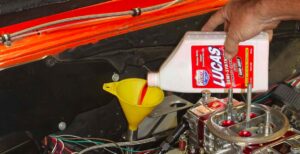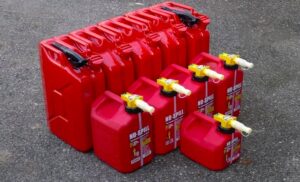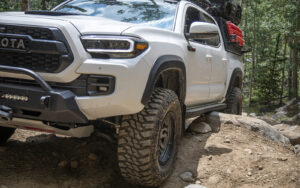Unless you’ve been living under a rock for the last several decades, you’re probably familiar with WD-40. It’s that miracle lubricant that can fix just about anything.
You can find it in practically every garage in America, and people have been using it for all sorts of things for generations. But what happens if you put WD-40 in gas tank? Is it really a viable fuel additive, or is this just an old wives’ tale?
Before we answer that question for you, let’s talk a bit more about WD-40 and its uses.
Table of Contents
What Is WD-40?
WD-40 is a multi-purpose lubricant that can be used on a variety of surfaces to protect against rust and corrosion. It can also be used to clean, degrease and lubricate moving parts. WD-40 is available in aerosolized form, making it easy to apply.
WD-40 can be used on:
- Knives
- Tools
- Fishing Reels
- Door Locks
- Bicycles
Applying WD-40 to these objects can help keep them rust-free and operating smoothly.
Uses of WD-40
There are many uses of WD-40, but the most common ones are:
- WD-40 is ideal for lubricating moving parts like door hinges, bicycle chains, and more.
- WD-40 can help protect wrought iron outdoor furniture from rust.
- WD-40 can be used to clean grease stains from clothing.
- WD-40 can be used to remove gum from hair.
- WD-40 can be used to remove smudges from cell phone screens.
- WD-40 can be used to clean grease stains from cooking utensils.
- WD-40 can be used to remove permanent marker stains from clothing.
- WD-40 can be used to clean up spilled nail polish.
- WD-40 can be used to remove crayon marks from windows, walls, etc.
- WD-40 can be used to clean dirt and grime from patio furniture.
- WD-40 can be used to remove stains from carpeting.
- WD-40 can help clean your tools.
- 13. WD-40 can be used to clean up spilled coffee.
- WD-40 can be used to clean and polish chrome fixtures and faucets.
- WD-40 can remove ink from carpets, leather, and other fabrics.
- WD-40 can lubricate squeaky doors, drawers, and small rolling toys.
- WD-40 can remove adhesive from price tags, labels, and stickers.
- WD-40 can clean and soften paintbrushes.
- WD-40 can loosen stubborn zippers (just be careful around the clothing!)
- WD-40 can help keep bugs at bay.
- WD-40 can help remove scuff marks and gunk from ceramic floors.
- WD-40 can be used to shine and remove fingerprints from stainless steel appliances.
- WD-40 can even be used as an insect repellent.
Can You Use WD-40 as Engine Oil?
As tempting as it may be to use WD-40 as engine oil, don’t do it! WD-40 is not designed for use as engine oil, and using it in this way can result in serious damage to your engine.
WD-40 is an oil, but it’s not the same as engine oil. If you use WD-40 as engine oil, it will quickly break down and leave your engine unprotected. This can lead to overheating and, eventually, engine failure.
So save the WD-40 for its intended purpose and use the right oil in your engine. Your engine will thank you for it in the long run!
Using a WD-40 as engine oil is strictly prohibited. However, that can’t overshadow what WD-40 can do with your engine.
WD-40 can be used to clean your car engine covers. Over time, dirt and rust can build up on engine covers, but WD-40 can help to keep them clean. This can protect your engine from dirt and debris and help keep it looking new.
It also works well for your spark plugs. Unfortunately, they can also accumulate dirt and rust over time, so they should be cleaned regularly to ensure that your car’s engine performs well.
However, if you use WD-40 all over your engine, it could cause severe problems. The WD-40 can seep into the engine’s oil chambers and dilute the oil, reducing its lubricating ability and leading to engine damage.
WD40 in Gas Tank – How Great of an Idea Is that?
It’s no secret that WD-40 can be used for various purposes. From lubricating door hinges to fixing a squeaky fan, this versatile product seems like it can do it all. So it’s no surprise that some people think WD-40 would make a great addition to their gas tank.
After all, WD-40 is designed to protect the metal from rust and corrosion. So adding it to your gas tank should help keep your engine clean and running smoothly, right?
Wrong. Putting WD-40 in gas tank is a bad idea for several reasons.
For starters, WD-40 is not designed for use in gasoline engines. The chemicals in WD-40 can damage engine parts and cause your car to run less efficiently. WD-40 is designed to be a water displacement formula, which means it’s excellent for getting rid of the water but not so suitable for actually lubricating metal surfaces. In fact, WD-40 can actually cause more harm than good by gumming up carburetors and other engine parts.
Plus, WD-40 can attract dirt and grime, which can clog up your engine and lead to even more problems.
So if you’re looking for a way to protect your engine, stick to using the right products for the job. There are plenty of options out there that are specifically designed for use in gasoline engines. And they’ll do a much better job keeping your engine clean and running smoothly.
The Risk Associated With Putting WD-40 in Your Gas Tank
You might want to think twice if you’re considering putting WD-40 in your gas tank. While WD-40 can help to lubricate and protect metal surfaces, it’s not meant for use in engines. Using WD-40 as fuel additive can actually be quite harmful to your engine.
Here’s a look at some of the risks associated with putting WD-40 in your gas tank:
It Can Damage Engine Parts
WD-40 is designed to be a penetrative lubricant, which means that it can seep into small spaces and coat surfaces. This can be beneficial when used on metal surfaces but can also cause problems when used in an engine.
The WD-40 can actually coat engine parts and cause them to malfunction. In some cases, it can even lead to engine failure.
It can Deteriorate Fuel Quality
WD-40 is made up of several different chemicals, including petroleum distillates. These chemicals can break down your fuel’s quality, leading to poorer performance and decreased fuel economy.
It can Clog Fuel Injectors
The WD-40 can also clog fuel injectors, leading to engine hesitation and misfires. In severe cases, it can even cause engine damage.
It’s not an Approved Fuel Additive
WD-40 is not an approved fuel additive by the U.S. Environmental Protection Agency (EPA). This means that it doesn’t meet the stringent standards required for use in engines.
It Voids Engine Warranties
Using WD-40 in your engine will void most engine warranties. This means that if you have any problems with your engine, you won’t be covered by the manufacturer.
So, is it worth the risk to put WD-40 in your gas tank? We don’t think so. There are much better and safer ways to protect and lubricate your engine.
What to do if You Have Already Put WD-40 in Your Gas Tank
If you have accidentally put WD-40 in your gas tank, don’t panic. You can take a few steps to fix the problem and prevent any further damage.
First, remove the WD-40 from the gas tank as soon as possible. Use a siphon or pump to remove the WD-40 from the tank, being careful not to spill any gasoline in the process. Once the WD-40 is removed, flush the gas tank with fresh gasoline. This will help to remove any residue left behind by the WD-40 and prevent it from causing damage to your engine.
Next, change the oil in your car. The oil helps to lubricate and protect your engine, so it’s important to replace it if it becomes contaminated. Be sure to use the correct type and weight of oil for your car.
Finally, have your car serviced by a qualified mechanic. They will be able to inspect your engine for any damage that may have been caused by the WD-40 and make any necessary repairs.
By following these steps, you can help to prevent further damage to your car and ensure that it continues to run smoothly.
Alternatives to Using WD-40 as a Fuel Additive
If you’re looking for an alternative to using WD-40 as a fuel additive, there are a few things you can try. First, consider using a different type of oil. Many different oils can be used as fuel additives, so find one that works best for your engine. Second, try using a different type of additive. There are many various additives on the market, so find one that works best for your engine. Finally, you can always use a higher octane gas if all else fails. This will help to improve your engine’s performance and may help to prevent some of the problems that can occur when using WD-40 as a fuel additive.
Here are some types of fuel additives that will give your car an excellent performance and fuel economy boost.
Gas Treatments
There are a variety of gas treatments on the market, but most contain one or more of the following ingredients: polyisobutylene (PIB), silicone oil, mineral spirits, or kerosene. PIB is the most effective ingredient at preventing deposit build-up, but it can also cause engine sludge if not used correctly. Silicone oil helps lubricate and protect engine parts, while mineral spirits or kerosene can help dissolve already formed deposits.
Fuel Injector Cleaner
Fuel injector cleaners contain various chemicals that help remove deposits from your fuel injectors. Polyisobutylene (PIB), petroleum distillates, and alcohols are the most common ingredients. PIB is the most effective at removing deposits but can also damage fuel injectors if not used correctly. Petroleum distillates are less effective at removing deposits but less likely to damage fuel injectors. Alcohols can also be used to clean fuel injectors, but they can evaporate quickly, so they’re not as effective at removing stubborn deposits.
Fuel Stabilizer
Fuel stabilizers help keep your fuel fresh and prevent it from breaking down over time. The most common ingredient in fuel stabilizers is ethylene glycol, which helps inhibit the growth of bacteria and fungi that can cause fuel to break down. Ethylene glycol can also help prevent rust and corrosion in your fuel system.
Octane Booster
Octane boosters are chemicals that raise the octane rating of your fuel, making it more resistant to knocking and pinging. The most common ingredient in octane boosters is methyl tertiary butyl ether (MTBE), which raises the octane rating of gasoline by 3 to 5 points. MTBE can also help improve engine performance and fuel economy. Other ingredients in octane boosters include lead, manganese, and zinc.
Wrapping Up
After all that, we can safely say that WD-40 is not a suitable option to put in gas tank. However, you can use any of the fuel additives we mentioned earlier. When using any type of fuel additive, be sure to follow the directions on the package carefully. Improper use of fuel additives can damage your engine or void your warranty. If you’re unsure which fuel additive is right for your vehicle, consult your owner’s manual or ask your mechanic.




